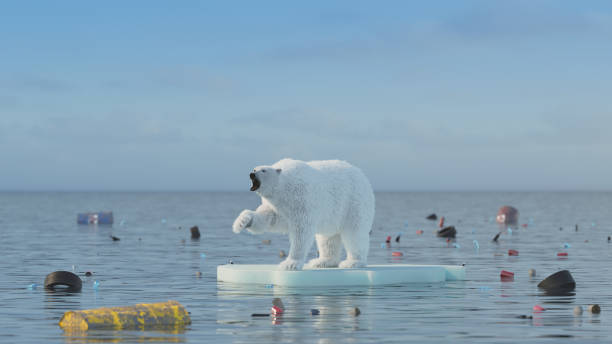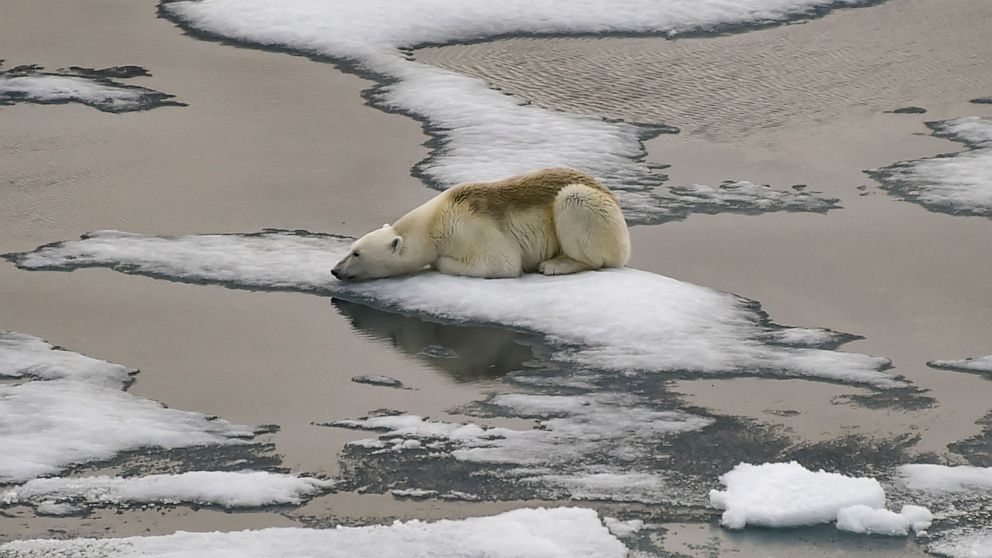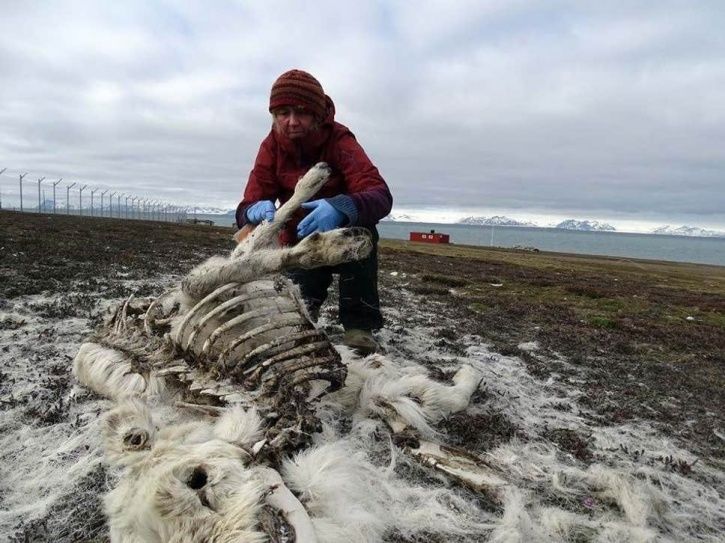Man’s Selfishness Claims Its Victims; Antarctica Sea Ice Reaches Historic Low Levels Playing Havoc With Arctic Ecosystem And Animals Alike
The Antarctica is undergoing a profound transformation driven by climate change thanks to the unchecked selfishness of Humans, and one of the most alarming consequences of global warming in this remote region is the rapid disappearance of sea ice. As carbon emissions from various sources, including cars and factories, continue to rise, the Arctic's sea ice is dwindling at an unprecedented rate. While the impact of this phenomenon extends far beyond the Arctic Circle, it poses an immediate and severe threat to the region's delicate ecosystem.

The sea ice encircling Antarctica has reached historically low levels, a concerning development revealed by satellite data; this (expected) benchmark raises significant alarm within the scientific community, challenging the prior notion that Antarctica was relatively resistant to the effects of global warming.
Walter Meier, an expert overseeing sea-ice monitoring at the National Snow and Ice Data Center, describes the situation as “mind-blowing”, and the consequences of a destabilized Antarctic ecosystem are far-reaching, warn polar experts.
Antarctica’s vast expanse of ice plays a pivotal role in regulating global temperatures by reflecting sunlight and cooling nearby waters, and without this cooling effect, Antarctica could shift from being Earth’s refrigerator to a heat contributor.
The extent of sea-ice in the Antarctic Ocean has dipped below 17 million square kilometres, a deficit of 1.5 million square kilometres compared to the September average and significantly below previous winter records.

To put it into perspective, this missing ice amounts to an area roughly five times the size of the British Isles, and what is even more concerning is that Dr. Meier expresses pessimism about the prospects of a substantial recovery in sea-ice levels.
What We Sow Is What We Reap
In a year marked by record-breaking global heat and ocean temperatures, some scientists emphasize that the declining sea-ice levels should be a focal point of concern and echoing the sentiment is Dr. Robbie Mallet from the University of Manitoba, stationed on the Antarctic Peninsula, who emphasises the region’s heightened vulnerability.
The thinning sea-ice, combined with the already harsh conditions of isolation, extreme cold, and powerful winds, has made scientific research more challenging and dangerous; Dr. Mallet even acknowledges the risk of sea-ice breaking off and drifting out to sea with researchers on it.
Sea-ice forms during Antarctica’s winter (March to October) and melts predominantly during the summer and is a crucial component of a complex interconnected system that includes icebergs, land ice, and extensive ice shelves that extend from the coast; it acts as a protective shield for land ice and helps prevent ocean heating.
As sea-ice decreases, dark areas of the ocean are exposed, absorbing sunlight and contributing to the ice-albedo effect, which, in turn, intensifies heat absorption in the water, further accelerating ice melt and disrupting Antarctica’s role as a global temperature regulator.

Are We Ready As The Giant Awakens
Scientists like Prof. Martin Siegert of the University of Exeter express concerns about the possibility of “awakening this giant of Antarctica,” which could have catastrophic consequences for the world.
There are indications that current events in Antarctica, particularly concerning its ice sheets, may fall within the worst-case scenario projections. Since the 1990s, Antarctica’s land ice loss has already contributed significantly to rising sea levels, with even modest increases in sea levels leading to dangerous storm surges that could devastate coastal communities worldwide.
Antarctica’s unique weather and climate system, surrounded by water, has experienced extreme weather events, including an unexpected heatwave in East Antarctica in March 2022; these events were once deemed improbable in the region.
Sea-ice has broken record minimums during the summer for three of the past seven years, including February 2023, prompting some scientists to suggest that a fundamental shift in the conditions protecting the continent is underway.
Despite advancements in scientific understanding, much remains unknown about Antarctica’s climate system, and the region is often described as the “Wild West” in scientific terms.
Scientists are working to unravel the causes of the vanishing winter ice, considering natural variability, warmer ocean temperatures, changes in ocean currents, shifts in wind patterns, and the potential influence of the El Niño weather phenomenon.
The urgency of these concerns is highlighted by the emergence of “very, very good reasons to be worried.” as the current situation may represent an alarming sign of Antarctic climate change that has not been witnessed in the past four decades and is now just beginning to emerge.
Consequences, A Wave Too Big To Ride
A new report highlights the alarming consequences of rapidly melting Antarctic ice on deep ocean currents and the potentially disastrous impact on the climate.
Australian scientists warn that the deep-water flows responsible for driving ocean currents could decline by as much as 40% by 2050; these currents play a critical role in transporting heat, oxygen, carbon, and nutrients across the globe.
A slowdown in these currents could have far-reaching effects, including potentially cooling Europe due to a decrease in the North Atlantic current. Additionally, the report suggests that the reduced circulation could hinder the ocean’s capacity to absorb carbon dioxide from the atmosphere.
The study explains that deep ocean currents, known as “overturnings,” have been relatively stable for thousands of years; however, the warming climate is disrupting these currents, primarily as a result of freshwater from melting ice caps, which dilutes the salt water and reduces its density, slowing the downward movement.
Lead researcher Professor Matthew England warns that if global carbon emissions continue at the current pace, the Antarctic overturning could slow by more than 40% over the next three decades, potentially leading it on a path toward collapse.
A significant weakening of the Atlantic Ocean circulation system was already observed in the 2018 Atlas Study, which found that it had become weaker than in the past 1,000 years; these changes could impact ocean temperature and ecosystems.
The report also emphasizes the potential consequences of this slowdown on marine ecosystems and Antarctica itself. The overturning currents play a crucial role in recycling nutrients for the global ecosystem and fisheries. Moreover, the report highlights the possibility of a feedback loop where warmer waters entering the region could lead to increased ice melt and further disrupt the circulation.
:max_bytes(150000):strip_icc()/global-warming--conceptual-image-168835034-5a25a9937bb283001930aaea.jpg)
We Are Killing Them
The disappearing sea ice in the Arctic, primarily driven by global warming resulting from increased carbon emissions, poses a severe threat to the region’s ecosystem. This loss of sea ice not only leads to increased global temperatures due to reduced reflectivity of solar rays but also endangers various species in the Arctic.
Impact on Arctic Species: The reduction in sea ice has serious consequences for indigenous Arctic species, including seals, fish, wolves, foxes, and polar bears.
Sea ice serves as a hunting platform for polar bears, while it also connects communities of land animals like foxes and wolves, but as the sea ice retreats, these animals are forced to move farther north, potentially reaching a limit where survival becomes challenging.

Disruption of the Food Chain: Sea ice plays a pivotal role in the Arctic food chain as it provides a surface for algae to grow.
Algae, found on the underside of sea ice, experiences a surge in growth during spring and forms the basis of the entire food chain in the region. Zooplankton feed on this algae, which fish, seals, and polar bears then consume; therefore, if algae levels decrease, the entire food chain is disrupted.
Shift in Zooplankton Species: In recent years, a critical zooplankton species, Calanus glacialis, has been declining in numbers and range, and instead, a temperate species called Calanus finmarchicus has appeared, which contains less fat and is of lower nutritional quality.
This shift in zooplankton species can have cascading effects on the Arctic ecosystem.

Isolation of Wolves and Foxes: The diminishing sea ice is extending the time during which packs of wolves and foxes are isolated from each other, and this prolonged isolation threatens to reduce cross-breeding and genetic diversity among these populations.
Impact on Narwhals: Narwhals, known as the “unicorns of the sea,” rely on sea ice for protection against their natural predator, killer whales. As sea ice diminishes, narwhals could become more vulnerable, endangering their populations.

Additional Threats
Researchers also highlighted other dangers, including the risk of thin or late-formed sea ice breaking, leading to seal pups drowning.
Moreover, increased rain instead of snow during warm spells can create hard coatings on the ground, making it difficult for reindeer and caribou to find food, affecting their populations.
Changes in the timing of plant blooming and caribou’s breeding cycles due to warming are further challenges affecting Arctic wildlife.
The Last Bit, The Arctic’s sea ice, once a resilient part of the region’s landscape, is now under relentless assault from climate change.
Its disappearance not only accelerates global warming but also endangers the very foundation of the Arctic ecosystem; from polar bears struggling to find hunting platforms to zooplankton facing shifting species dynamics, the effects ripple through every level of the Arctic food chain.
As we witness the alarming consequences of melting sea ice, it becomes clear that urgent and comprehensive action to combat climate change is essential.
Protecting the Arctic and its unique wildlife is not just an environmental concern; it is a global imperative, and as all are connected, our survivability is equally threatened.



